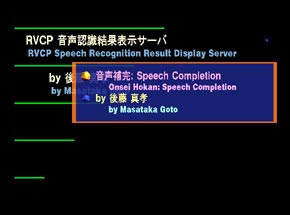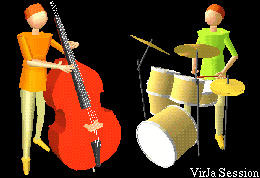Japanese version is here.

I was recruited as a researcher of PRESTO (Precursory Research for Embryonic Science and Technology), JST (Japan Science and Technology Corporation), working in the research area of "Information and Human Activity" from October 1st, 2000 to September 30th, 2003. My research theme as a PRESTO researcher is "Building a Real-time Music Scene Description System". The press release by JST is here (in Japanese).
Our research paper entitled "Real-time Beat Tracking for Musical Audio Signals"
was given the
Best Paper Award for Young Researchers of
The 1998 Kansai-Section Joint Convention of
Institutes of Electrical Engineering, Japan
on April 9, 1999.
I would like to express my gratitude to
everybody who has supported this project.
The recent progress on my research project,
A Real-time Beat Tracking System for Musical Acoustic Signals, was also reported in the
Proceedings of the 1998 International Computer Music Conference,
pp.17-20, October 1998 and
Speech Communication, Vol.27, Nos.3-4, pp.311-335, April 1999.
My articles
"Beat Tracking" and "Networked Musical Information Processing Systems"
were published in "Computer and Music World",
which is a separate volume of
Japanese computer science magazine "bit"
(Kyoritsu Shuppan,
August 1998 [6800 yen]).
They include up-to-date introductions of my research projects,
A Real-time Beat Tracking System for Musical Acoustic Signals and
RMCP (Remote Media Control Protocol).

We will perform a remote session "Internet RemoteGIG" between
Tokyo (NTT ICC) and New York (Columbia University) in
U.S.A./Japan InterCollege Computer Music Festival.
The session will start at 11:00 a.m. on December 14th, 1997 (JST).
RemoteGIG is an innovative remote session over the Internet that has a
long delay. It turns the inevitable network latency to its advantage
and offers a new possibility for future remote sessions. RemoteGIG is
an application of the RMCP (Remote Media
Control Protocol), which can provide the bidirectional relay of
packets including MIDI messages over the Internet.
This concert succeeded thanks to everybody who has supported this project. With regard to music with tonality and rhythm, it was the first remote session over the Internet in the world.

Our research paper on VirJa Session was given the IPSJ SIG Research Award 1997 in September, 1997. This award was reported in the Journal of Information Processing Society of Japan (Vol.38, No.11) in November, 1997. I would like to express my gratitude to everybody who has supported this project.
Our research project on VirJa Session was reported in the morning edition of the daily newspaper Nihon Keizai Shimbun on September 20th, 1997 and in the weekly campus newspaper Waseda Weekly on November 6th, 1997.

VirJa Session
will debut at ACM SIGGRAPH '97 !
We will demonstrate VirJa Session on VRML 2.0
at
IBM Exhibition Booth (Booth 1153)
(Los Angeles, August 5th-7th, 1997).
Our VirJa Session on VRML 2.0 works on
IBM QoS-able VRML 2.0 Browser.
My beat-tracking research was reported in a column "R&D focus" of Computing Japan (May 1996, pp.17-18, [$5.95]), which is the English magazine of computing trends, technology, and resources in Japan. The article is entitled "Research in Modeling Musical Knowledge: We visit Masataka Goto of Waseda University's Muraoka Laboratory." I was interviewed by Steven Myers, a senior editor of Computing Japan, on December 22, 1995.
My article
"Can Computer Keep Time to Music by Hand-clapping?
--- A Real-time Beat Tracking System ---"
will be published in the Japanese computer science magazine
"bit"
(Vol.28, No.3, pp.4-11,
Kyoritsu Shuppan,
March 1996 [800yen]).
This is an up-to-date introduction of
A Real-time Beat Tracking System for Musical Acoustic Signals.

A virtual dancer Cindy will debut in the television program "Tameshite Gatten" on NHK! This program will be broadcast during 20:00-20:39 on December 20th, 1995.
Cindy has been developped as a good example in which A Real-time Beat Tracking System for Musical Acoustic Signals is very useful.

A virtual dancer Cindy will debut at IJCAI'95 CASA workshop (Montreal on A ugust 19-20) and ICMC'95 (Banff on September 4) .
We have developped an application that displays a CG dancer whose motion changes with musical beats in real time. This application has shown that our system is also useful in various multimedia applications in which human-like hearing ability is desirable.
All pages are copyrighted by the author. Unauthorized reproduction is strictly prohibited.
last update: June 2, 2004